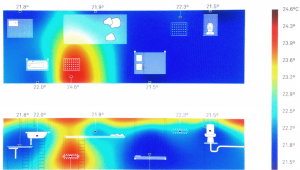Designing for what we can not see
1) Domestic Astronomy by Phillippe Rahm 2) Weather Project by Ólafur Elíasson
Form Follows Function, function follows form, and according to Rahm form and function follow climate. Rahm suggests a change in the architects discipline from relying on the aesthetic and visibly tangible to invisible dimensions and parameters that are quantifiable. Rahm investigates the relationship between the form of architectural spaces to the human body through atmospheric and invisible logistics. Through sensors such as electromagnetic fields, atmospheric humidity levels and temperature, air circulation, and light he creates forms to enhance and optimize our human needs.
In his work, Rham intends to liberate the space from a specific function, giving free reign to the function of interaction within the space by exploring of the natural processes that happens within the form. Moving away from the classical ideas that form is derived from the dimensions of the human body and the function of the space, Rham uses form as determining the function. Domestic Astronomy (pic 1) Rahm’s work manipulates the space using convection to determine the function. Weather Project (pic 2) by Eliasson, gave museum goers a chance to experience a fake “sun” manipulating the human body experience.
Move away from the building and what it contains, analyze what happens within the void. Through this scientific evaluation of the invisible characteristics of the space (air flow, temperature, and humidity) architects can create forms from these observations. Rahm believes that intangeable, atmospheric, psychological, and physical relations and logistics now encompass the architectural discipline and must be considered when creating spaces.
The scientific invisible dimension leaves “physical” architecture in the past and hopes to focus on “psychological/atmospheric” architecture of the future. The discovery of atmospheric architecture has opened up a discussion and design, from tangible materials to focus on the scientific properties and happenings of a room. Using data collection and sensors, rooms can be interperated as live forms through the use of thermal imaging and x-rays, level of humidity, odor, and wave length monitors and sensors. This moves architecture away from the visual and aesthetic dimension and toward the scientific realm.
Topic of interest: Is architecture that is moving toward an invisible dimension. Can scientific progress enhances architecture? How can we learn and alter forms from the data created to better interact with our spaces? Are the introduction of artificial senses illusions to manipulate our psychological state?


